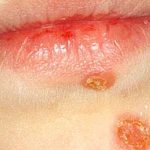 A contagious, bacterial skin infection characterized by blisters that may itch, caused by a Streptoccocus bacterium or Staphylococcus aureus and mostly seen in children.
A contagious, bacterial skin infection characterized by blisters that may itch, caused by a Streptoccocus bacterium or Staphylococcus aureus and mostly seen in children.
A highly contagious skin infection caused by bacteria, usually occurring around the nose and mouth; commonly occurring in children.
Gym itch. A bacterial skin infection caused by either the streptococci or staphylococcus bacteria. It is transmitted from the skin lesions, either directly or indirectly, from the infected person. Characterized by pink lesions filled with fluid that becomes pus-filled and finally crusty.
An irritating and very contagious skin disease caused by staphylococci, which spreads rapidly and is easily passed from one child to another, but can be treated with antibiotics.
Bacterial (usually streptococcal and/or staphylococcal) infection of the skin, common in children and very contagious, in which localized skin redness develops into fluid-containing small blisters that gradually crust and erode. Treatment is by topical and sometimes oral antibiotics, careful washing, and steps to prevent the spread of the infection.
Contagious skin condition caused by streptococci or staphylococci bacteria.
A skin infection, primarily affecting the face and extremities, that occurs most frequently in babies and small children. It’s usually caused by Staphylococcus or Streptococcus bacteria. Red skin areas change to blisters that open and become covered with yellow crusts.
A contagious, superficial skin infection. Impetigo is caused by Staphylococcus and Streptococcus bacteria, and most commonly occurs on unexposed areas of the arms, legs, and face.
A bacterial skin infection usually caused by staphylococci, though occasionally by streptococci. Impetigo is particularly common in babies and children, occurring mainly on the face and limbs. The infection, which spreads quickly over the body, starts as a red patch and develops into small pustules that join together, forming crusty yellow sores. Impetigo is very contagious, especially in communities of children, being readily spread by contact and via towels and face cloths. The condition usually responds to treatment with antibiotics, applied locally, within 7 to 10 days. Impetigo of the newborn is rare today but an outbreak may spread rapidly in a maternity unit.
A contagious skin disease, more common in children, caused usually by Staphylococcus aureus and less often by Streptococcus pyogenes. The itching rash is seen especially on the face but may spread widely. Vesicles and pustules erupt and dry to form yellow-brown scabs. Untreated, the condition may last for weeks. In very young infants, large blisters may form (bullous impetigo).
Contagious bacterial skin infection characterized by weeping lesions.
This is a highly infectious skin infection, frequently observed in children, that predominantly occurs around the nose and mouth. However, it can affect the skin anywhere on the body.
Impetigo is a result of bacteria, typically staphylococci, infiltrating areas of damaged skin. The skin becomes red and small, fluid-filled blisters form. These blisters are prone to bursting, which leaves behind moist, weeping regions that dry to form honey-coloured or golden crusts. In serious cases, there may be swelling of the lymph nodes in the face or neck, along with fever.
Treatment typically involves the application of topical antibiotic medications, unless the condition is widespread. In cases of extensive impetigo, oral antibiotics are usually administered.
Since the condition is highly infectious, to halt the spread of the infection, items such as towels, washcloths, and pillowcases should not be shared. Children should avoid attending school or interacting with others until they have received treatment and the condition has resolved.
A broad term for skin conditions characterized by inflammation and pus-filled lesions.
